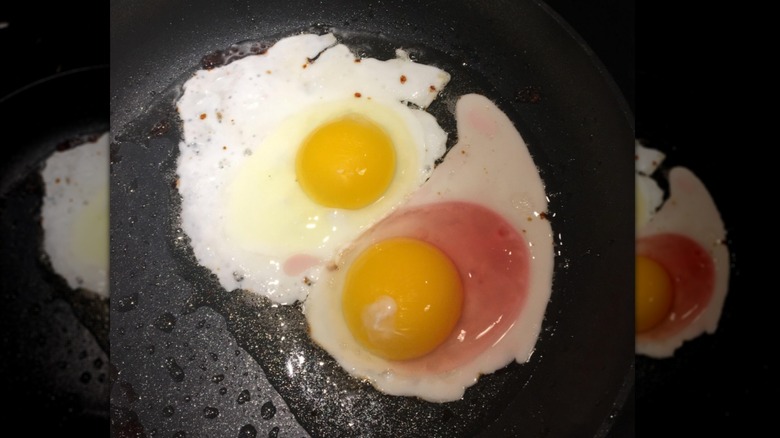What Is A Meat Spot In An Egg, And How Is It Different From A Blood Spot?
So you cracked your eggs for a scramble (or cake, or cookies, or omelet), and you found a suspicious spot floating around in your egg whites. You might be wondering what that little speck is, or if it's safe to eat. Well, there's a good chance that that small bit floating around in your egg whites is a meat spot.
A meat spot forms while the shell of the egg is still undeveloped. It is a piece of tissue from the laying hen's oviduct that becomes embedded in the white of the egg as it passes through the hen's reproductive system. And though this tissue is called a meat spot, it isn't meat and does not indicate a fertilized egg. These spots are usually a brown or white color and tend to be small in size, and commercially produced eggs are only allowed to be sold with meat spots that are at or below one-eighth of an inch in diameter, according to the USDA. Ultimately, meat spots have no impact on the quality of your egg and are perfectly safe to eat; though hens that are fed a well-rounded diet tend to produce eggs with more meat spots so they could indicate a well-fed bird.
However, that little speck in your egg could also be a blood spot, a tiny spot of blood in the yolk of an egg. Meat spots and blood spots are harmless quirks that you might find in your eggs, but knowing more about them can help you better understand the intricacies that go into your egg dishes.
You're not likely to see these spots in grocery store eggs
We know that meat spots do not indicate a fertilized egg. However, meat spots and blood spots can be a sign of freshness. Blood spots usually diffuse into the yolk over time while meat spots tend to dissolve into the egg after a certain period. This is probably why you haven't seen many, if any of these spots in your grocery store eggs, as many of these eggs are less fresh than those that come straight from the farm (or farmer's market). Beyond this, white eggs, which are the most popular type of egg sold in America according to Business Insider actually have a lower occurrence of meat spots than brown eggs.
Additionally, many industrial poultry farms use a method called candling to check for large blood or meat spots. Candling is a process in which a large light is shone through eggshells so that the inside is visible (at least in part). This process helps egg producers spot any potential internal issues, including large meat spots.
Some not-so-good spots
But not all spots in your egg are safe. And while meat and blood spots might even be a sign that your egg is fresh, there are some variations that you should look out for.
The USDA explains that the albumen or egg white can range from a clear to a cloudy white color. Either is safe to eat, though clearer albumen indicates a fresher egg. The color of egg yolks, on the other hand, can come in a variety of yellow shades from bright sunny yellow to deep orange. Where the yolk falls on this spectrum is a result of the hen's diet, but all of these yellow shades are normal. However, if your eggs have an odd tint that is pink, red, green, or a fluorescent color, you should not consume them, as this is a sign that they may have spoiled due to Pseudomonas bacteria. Unlike meat spots and blood spots which are perfectly safe to eat, these are the types of discoloration in eggs you definitely want to avoid.


